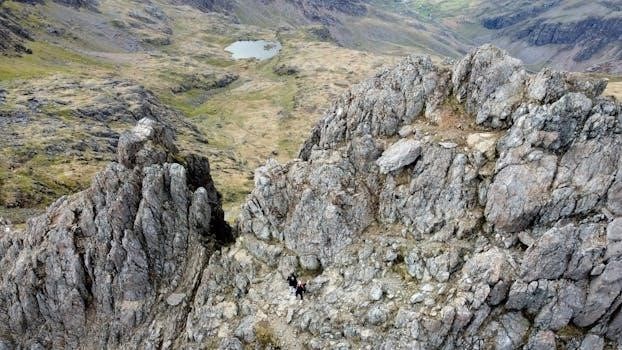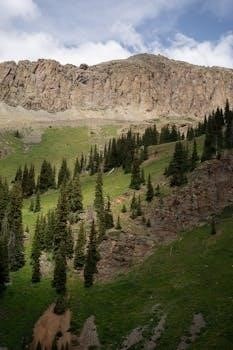
AP Human Geography Unit 3 Test⁚ Key Concepts
Unit 3 delves into the core elements of cultural geography, focusing on the patterns and processes that shape human societies․ Key concepts include cultural traits, diffusion, landscapes, globalization’s impact, and the interplay of language, religion, and ethnicity․ Understanding these elements is crucial for success on the exam․
Welcome to Unit 3 of AP Human Geography, where we explore the fascinating world of cultural geography․ This unit delves into the intricacies of how culture shapes our world, focusing on the complex interplay of human societies and their environments․ We’ll examine the patterns and processes that create the diverse cultural landscapes we see today, from the languages we speak to the religions we practice․ Through a lens of diffusion, we’ll trace how cultural traits spread across the globe․ The unit will also address the impacts of globalization on cultural identity and the distinctions between folk and popular culture․ Get ready to explore the dynamic realm of human culture and its profound influence on our planet․ This unit is crucial for understanding the human experience and its geographic dimensions, which are essential for the AP exam․ We’ll also emphasize the importance of cultural landscapes and their reflection of human values and practices․
Core Concepts of Cultural Patterns
In this section, we will examine the core concepts that underpin cultural patterns around the world․ We’ll explore the idea of cultural traits, the specific elements that make up a culture, and how they contribute to a group’s identity․ Understanding the diffusion of cultural traits is also key, as we’ll look at how ideas, beliefs, and practices spread through various mechanisms such as relocation and expansion diffusion․ The concept of cultural landscapes will be explored, examining how human activities and cultures are superimposed onto physical environments․ This section also emphasizes the distinction between folk and popular culture, including their origins, diffusion patterns, and impacts․ It is essential to understand how these elements create the unique and diverse cultural patterns we see across the globe․ Also, we will look at how globalization changes and influences these patterns․

Language in Unit 3
This section explores the role of language in shaping cultures and societies․ We will examine language families, their diffusion, and the impact of lingua francas on global communication․ Understanding language is key to grasping cultural dynamics․
Language Families and Diffusion
This subsection delves into the fascinating world of language families and how they spread across the globe․ We will explore the major language families, such as Indo-European, Niger-Congo, and Sino-Tibetan, examining their origins and geographical distributions․ Understanding these families provides a framework for tracing linguistic connections and migrations․ The concept of diffusion is central, as we analyze how languages spread through relocation, hierarchical, and contagious diffusion․ We’ll also look at the factors that influence language diffusion, including trade, colonialism, and migration patterns․ Examining the impact of these processes helps explain the diverse linguistic landscape of the world․ Furthermore, we will explore the concept of language divergence and convergence, as well as language isolates․ By studying language families and diffusion, we can gain deeper insights into cultural interactions and the movement of peoples throughout history, which is essential for success on the AP Human Geography exam․
Lingua Franca and Global Communication
This section examines the role of a lingua franca in facilitating global communication and interaction․ A lingua franca is a language adopted as a common language between speakers whose native languages are different․ We will explore why certain languages become lingua francas, with a focus on the historical and contemporary factors that have led to the prominence of English as the world’s primary lingua franca․ The impact of globalization on language use will be discussed, particularly how it promotes the spread of lingua francas․ Additionally, we will analyze the challenges and opportunities associated with global communication, such as language barriers, cultural misunderstandings, and the rise of new communication technologies․ Examining the role of lingua francas and global communication provides insight into the interconnectedness of our world and the evolving patterns of language use․ It is a vital part of understanding cultural interaction in Unit 3 of AP Human Geography․

Religion in Unit 3
This section explores the diverse religious landscape of the world, examining the differences between monotheistic and ethnic religions․ We will also analyze how religions diffuse and shape cultural landscapes through their practices and beliefs․
Monotheistic and Ethnic Religions
Unit 3 explores the distinction between monotheistic and ethnic religions, crucial for understanding global cultural patterns․ Monotheistic religions, such as Christianity, Islam, and Judaism, believe in one god and often seek to convert new followers․ Their global spread has profoundly impacted cultural landscapes․ In contrast, ethnic religions, like Hinduism and Judaism (in some interpretations), are typically associated with a particular ethnic group and do not actively seek converts․ These religions are often deeply rooted in specific geographic locations and cultural traditions․ Understanding the differences in their origins, diffusion patterns, and spatial impacts is essential․ We will examine how these religions shape cultural practices, social structures, and the built environment․ Recognizing these distinctions is vital for analyzing human-environment interaction and cultural diversity in the context of geography․
Religious Diffusion and Landscapes
The diffusion of religions across the globe has dramatically shaped cultural landscapes․ Religions spread through various mechanisms, including relocation diffusion, where adherents migrate and carry their beliefs, and expansion diffusion, where religions spread outward from their origin points through contagious, hierarchical, or stimulus diffusion․ The resulting religious landscapes are marked by distinct architectural styles, sacred sites, and places of worship, reflecting the unique characteristics of each faith․ For example, the presence of mosques in Islamic regions or churches in Christian areas transforms the physical environment and provides a tangible manifestation of religious beliefs․ Religious diffusion also impacts political boundaries, social norms, and cultural practices, often leading to complex interactions and sometimes conflicts․ Examining these patterns helps us understand the dynamic relationship between religion and geography․

Ethnicity and Culture
This section explores the intricate connections between ethnicity and culture․ It examines how cultural traits shape identities and how these identities are expressed through folk and popular cultures․ Understanding these dynamics is essential․
Cultural Traits and Identity
Cultural traits are the building blocks of cultural identity, encompassing everything from language and religion to customs and traditions․ These traits are often passed down through generations, shaping how individuals perceive themselves and their place in the world․ Cultural identity is a complex and multifaceted concept, influenced by various factors, including ethnicity, nationality, and social class․ Examining the spatial distribution of cultural traits helps us understand the diversity and complexity of human societies․ Cultural identity is not static; it is constantly evolving as individuals and groups interact with each other․ The diffusion of cultural traits can lead to both cultural convergence and divergence․ Studying cultural traits and identity provides vital insights into the richness of human experience, and is a key focus of AP Human Geography Unit 3․ Understanding the formation of cultural identities is crucial for comprehending cultural landscapes and interactions․ The interplay of individual and collective identities, as well as the ways in which they are asserted and negotiated, is central to the study of cultural geography․
Folk and Popular Culture
Folk culture represents the traditional practices of small, homogenous groups, often isolated from larger societal trends․ It is characterized by its unique customs, often localized and passed down through generations․ Popular culture, conversely, is the widespread, ever-changing set of practices and beliefs that dominate large, heterogeneous societies․ It’s often driven by mass media and technological advancements․ The diffusion of popular culture is typically rapid, while folk culture often spreads through relocation diffusion․ The distinction between folk and popular culture is not always clear-cut, as elements of folk culture can be appropriated and transformed into popular forms․ Understanding the interplay between folk and popular culture is vital to grasp cultural change․ Globalization facilitates the spread of popular culture, but also threatens the diversity of folk traditions․ Cultural landscapes often reflect the influence of both folk and popular culture․ The contrast between these cultural forms allows one to analyze the dynamics of cultural change and continuity․

Practice and Review
To solidify your understanding of Unit 3, utilize practice quizzes and tests․ Review free-response examples, and remember to develop effective test-taking strategies to ensure success on the exam․
Multiple Choice Practice Questions
Engage with a variety of multiple-choice questions designed to assess your knowledge of Unit 3’s key concepts․ These questions will cover topics such as language families, religious diffusion, cultural landscapes, and the dynamics of folk and popular culture․ Practice tests often include questions that mimic the format and difficulty level of the actual AP exam, allowing you to identify areas where you need further review․ Be sure to analyze why the correct answer is right and why the other options are incorrect; this is a vital study technique․ Questions will cover diffusion patterns, cultural traits, the impacts of globalization, and the distinctions between different types of religions and cultures․ Use these practice questions to enhance your comprehension of the material․ Reviewing these questions will expose you to the exam’s question structure, improving your ability to answer effectively․ Many online resources provide free practice questions, often with immediate feedback and detailed explanations, which are essential tools to use․
Free Response Question Examples
Familiarize yourself with free-response question examples that test your ability to synthesize information and construct well-supported arguments․ These examples often require you to analyze cultural patterns, explain diffusion processes, and evaluate the impact of globalization on different regions․ Practice writing clear, concise responses that integrate relevant geographic concepts and evidence․ Free-response questions might ask you to compare different types of religions or cultures, describe the effects of language on society, or analyze the cultural landscape of a specific area․ Look for examples that focus on the key concepts and themes of Unit 3․ These question examples will help you understand the expectations for the free-response section of the exam․ Be prepared to support your claims with specific examples and geographic terminology․ Examine past AP exam questions and model answers to understand how to score the highest points possible․ Practicing with various free-response question examples will greatly improve your exam performance․ Many online resources provide example free-response questions that can be used in exam preparation․
Test Taking Strategies for Unit 3
Effective test-taking strategies are essential for maximizing your score on the Unit 3 exam․ First, carefully read each question to understand the specific requirements, noting any key terms or concepts․ When tackling multiple-choice questions, eliminate obviously incorrect answers before selecting the most appropriate one․ For free-response questions, plan your answer before you start writing, outlining the main points you want to make․ Be sure to use geographic vocabulary accurately and support your arguments with specific examples․ Pace yourself during the test to ensure you have enough time to complete all the questions․ Manage your time effectively by allocating time per question based on its point value․ If you get stuck on a question, move on and come back to it later if time allows․ Remember to answer all parts of the free-response question in a clear and concise manner․ Practice consistently with sample tests to get accustomed to the format and timing․ Thoroughly review the material, and identify areas where you need additional studying․